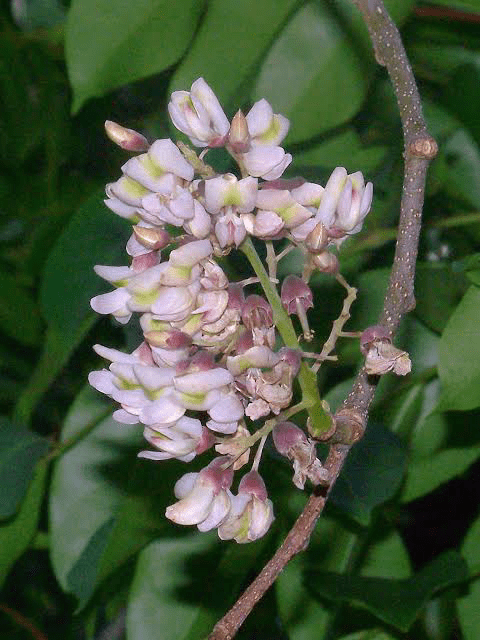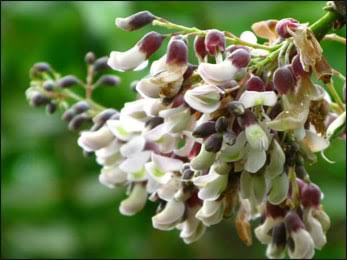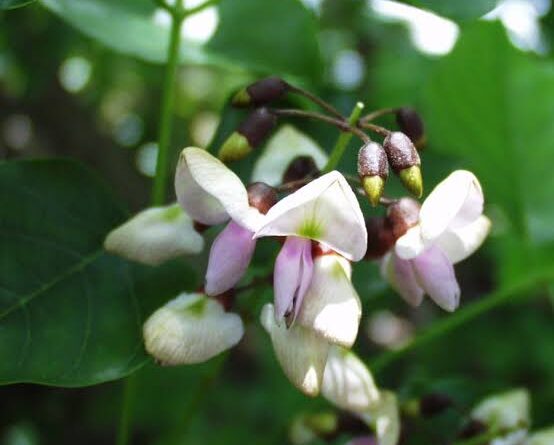18 Medicinal Health Benefits Of Jamaica Dogwood (Piscidia piscipula)
Jamaica Dogwood, scientifically known as Piscidia piscipula, is a remarkable medicinal plant with a rich history of traditional use and a wide range of health benefits. In this article, we’ll discuss its medicinal properties, its botanical description, and its historical use in traditional medicine.
Jamaica Dogwood, also referred to as Fishfuddle, is a flowering tree native to the Caribbean and Central America. Its botanical name, Piscidia piscipula, reflects its piscine or fish-killing properties, as indigenous people historically used its bark to stun fish for easier capture. Beyond its piscine applications, Jamaica Dogwood has been prized for its potent medicinal qualities for centuries.
The historical use of Jamaica Dogwood in traditional medicine dates back centuries, with indigenous communities in the Caribbean and Central America employing various parts of the plant for medicinal purposes. Its traditional use is deeply rooted in Native American and Caribbean cultures, where it was utilized to treat a variety of ailments. The bark and roots of the Jamaica Dogwood tree were often prepared into teas, tinctures, or poultices to address specific health concerns.
The Botanical Description of Jamaica Dogwood
Understanding the botanical characteristics of Jamaica Dogwood is crucial for identification and appreciation of this medicinal plant. Here, we’ll list and explain seven key aspects of its botanical description:
1. Tree Size: Jamaica Dogwood is a medium-sized tree that can grow up to 30 feet (9 meters) in height.
2. Leaves: The tree’s pinnate leaves are composed of several leaflets, arranged in pairs along the leaf stalk. These leaflets are dark green and have a glossy appearance.
3. Flowers: Jamaica Dogwood produces clusters of small, fragrant, white or pale pink flowers. These flowers are typically arranged in terminal panicles.
4. Fruit: The tree bears small, woody, and somewhat curved pods that contain seeds.
5. Bark: The bark of Jamaica Dogwood is a notable feature, as it was historically used for medicinal purposes. It is dark brown and deeply furrowed.
6. Range: This tree is native to the Caribbean, Central America, and northern parts of South America.
7. Medicinal Parts: While various parts of the plant have been used medicinally, the bark and roots are the primary components utilized for their therapeutic properties.
The Geographic Distribution of Jamaica Dogwood
Understanding the geographic distribution of Jamaica Dogwood, scientifically known as Piscidia piscipula, provides insight into its natural habitat and range. Here, we’ll list and explain seven key aspects of its distribution:
1. Native to the Caribbean: Jamaica Dogwood is native to various Caribbean islands, including Jamaica (from which it gets its common name), as well as Cuba, Hispaniola, and Puerto Rico.
2. Central America: Beyond the Caribbean, this medicinal plant also thrives in Central American countries such as Honduras, Nicaragua, and Belize.
3. Northern South America: In northern South America, Jamaica Dogwood can be found in regions of Venezuela and Colombia.
4. Tropical Climates: Jamaica Dogwood prefers tropical climates with warm temperatures and ample rainfall, typically growing in lowland and montane rainforests.
5. Coastal and Inland: It is versatile in its habitat, growing both along coastal areas and in inland forests.
6. Altitude Range: While primarily a lowland species, it can be found at varying altitudes, from sea level to higher elevations in montane regions.
7. Conservation Concerns: Due to habitat loss and overharvesting, Jamaica Dogwood faces conservation challenges in some areas, prompting the need for sustainable harvesting practices.
The Chemical Composition of Jamaica Dogwood
1. Piscidinols: These unique compounds, such as piscidinol A and piscidinol B, are believed to be responsible for some of Jamaica Dogwood’s sedative and muscle-relaxant effects.
2. Resin: Jamaica Dogwood contains a resinous substance that has been used traditionally for its medicinal properties.
3. Isoflavonoids: Compounds like wistin and rotenone are isoflavonoids found in Jamaica Dogwood and may contribute to its bioactivity.
4. Tannins: Tannins are polyphenolic compounds present in the bark and roots, which have astringent properties and contribute to the plant’s traditional uses.
5. Flavonoids: Various flavonoids, such as apigenin and luteolin, have been identified in Jamaica Dogwood and may contribute to its antioxidant effects.
6. Terpenoids: Terpenoid compounds, which are common in many medicinal plants, have been found in Jamaica Dogwood and may contribute to its therapeutic potential.
These chemical constituents interact to produce the plant’s unique medicinal effects, making it a valuable resource in traditional and herbal medicine.
The Cultivation and Growth of Jamaica Dogwood
Understanding the cultivation and growth requirements of Jamaica Dogwood (Piscidia piscipula) is crucial for those interested in its sustainable production. Here, we’ll list and explain six key aspects of its cultivation and growth:
1. Soil Preferences: Jamaica Dogwood thrives in well-drained, loamy soils with good organic matter content. It prefers slightly acidic to neutral pH levels.
2. Sunlight Requirements: This medicinal tree typically prefers partial to full sunlight, making it well-suited for tropical regions with ample sunshine.
3. Water Needs: Jamaica Dogwood requires consistent moisture but is not tolerant of waterlogged conditions. Adequate rainfall or irrigation is essential for its growth.
4. Propagation: Propagation is often done through seeds, which should be scarified (outer coating broken) and soaked before planting. It can also be propagated through stem cuttings.
5. Growth Rate: Jamaica Dogwood is considered a slow-growing tree, and it may take several years for it to reach maturity and produce medicinal bark.
6. Pruning and Maintenance: Pruning should be minimal, as over-pruning can stress the tree. Regular monitoring for pests and diseases is important for its well-being.
The Harvesting and Processing of Jamaica Dogwood
The harvesting and processing of Jamaica Dogwood (Piscidia piscipula) play a crucial role in preserving its medicinal properties and ensuring its safe use. Here, we’ll list and explain seven key aspects of harvesting and processing:
1. Harvesting Bark and Roots: The bark and roots of the Jamaica Dogwood tree are the primary parts harvested for their medicinal properties. Harvesting should be done selectively to avoid harming the tree.
2. Timing of Harvest: The bark and roots are typically harvested when the tree is dormant, typically during the dry season when the sap content is lower.
3. Sustainable Harvesting: Sustainable harvesting practices are essential to protect Jamaica Dogwood populations from overexploitation. Regulated harvesting and replanting efforts help ensure a consistent supply.
4. Drying Process: After harvesting, the bark and roots are typically dried in the shade to preserve their medicinal compounds. Care must be taken to prevent mold and moisture during drying.
5. Storage: Proper storage conditions, such as airtight containers in a cool, dry place, are essential to maintain the quality of Jamaica Dogwood for medicinal use.
6. Processing into Medicinal Forms: The dried bark and roots can be processed into various medicinal forms, including teas, tinctures, capsules, and extracts.
7. Quality Control: Quality control measures, including testing for potency and contaminants, are crucial for ensuring the safety and efficacy of Jamaica Dogwood products.
Read Also: 15 Medicinal Health Benefits Of Akebia (Akebia Vine)
The Medicinal Health Benefits Of Jamaica Dogwood (Piscidia piscipula)

Jamaica Dogwood, scientifically known as Piscidia piscipula, offers a wide range of medicinal health benefits. Here, we’ll list and explain 18 of these valuable advantages:
1. Pain Relief: Jamaica Dogwood has analgesic properties and has been traditionally used to alleviate various types of pain, including headaches and muscle aches.
2. Sedative Effects: It exhibits sedative properties, making it useful for calming the nervous system and promoting relaxation.
3. Anxiety Reduction: Jamaica Dogwood may help reduce anxiety and ease symptoms of nervousness.
4. Sleep Aid: It can be used as a natural remedy for insomnia, improving sleep quality.
5. Muscle Relaxation: It’s known for its muscle-relaxant properties, potentially relieving muscle spasms and tension.
6. Antispasmodic: Jamaica Dogwood can help reduce spasms in the digestive tract, providing relief from conditions like irritable bowel syndrome (IBS).
7. Anti-inflammatory: It exhibits anti-inflammatory effects, potentially reducing inflammation in various parts of the body.
8. Respiratory Relief: Jamaica Dogwood has been used to soothe coughs and respiratory conditions, such as asthma and bronchitis.
9. Menstrual Pain: It may alleviate menstrual cramps and discomfort when used as a natural remedy.
10. Nerve Pain: Jamaica Dogwood is known for its ability to ease nerve pain, making it useful for conditions like neuralgia.
11. Antioxidant Properties: It contains antioxidants that help protect cells from oxidative stress and damage.
12. Blood Pressure Regulation: Some studies suggest that Jamaica Dogwood may have a beneficial impact on blood pressure levels.
13. Anti-anxiety: It can help reduce anxiety and promote a sense of calmness without the side effects of pharmaceutical drugs.
14. Mild Diuretic: Jamaica Dogwood has mild diuretic properties, which may aid in reducing fluid retention.
15. Antispasmodic: It’s effective in relieving gastrointestinal spasms, making it valuable for digestive health.
16. Skin Conditions: When applied topically, Jamaica Dogwood may help with skin conditions like eczema and psoriasis.
17. Stress Reduction: It aids in stress reduction by calming the nervous system and promoting relaxation.
18. Anti-allergic Effects: Some studies suggest that Jamaica Dogwood may have anti-allergic properties, which can be beneficial for those with allergies.
The Methods of Usage to Achieve the Provided Health Benefits Of Jamaica Dogwood (Piscidia piscipula)
To harness the health benefits of Jamaica Dogwood effectively, it’s essential to know the various methods of usage. Here, we’ll list and explain nine methods to achieve the provided health benefits:
1. Herbal Tea: Brewing Jamaica Dogwood bark into a herbal tea is a common method to consume it. Steep the dried bark in hot water and drink it.
2. Tinctures: Liquid extracts, or tinctures, are made by macerating the bark in alcohol or another solvent. These are taken in small doses.
3. Capsules and Tablets: Commercially available capsules and tablets containing Jamaica Dogwood extract offer a convenient way to take it.
4. Topical Applications: For skin conditions and localized pain relief, Jamaica Dogwood can be applied topically in the form of creams or ointments.
5. Poultices: A poultice made from the bark can be applied to sore muscles or areas of pain.
6. Inhalation: Steam inhalation with Jamaica Dogwood-infused water can help with respiratory issues and stress relief.
7. Syrups and Elixirs: Syrups and elixirs are sweetened liquid preparations that make it easier to consume Jamaica Dogwood.
8. Smoking Blend: In some traditional practices, Jamaica Dogwood bark was smoked to induce relaxation and calm.
9. Professional Guidance: Consultation with a healthcare practitioner or herbalist can provide personalized guidance on the best method and dosage for your specific health concerns.
The Side Effects Of Using Jamaica Dogwood Medicinal Plant
While Jamaica Dogwood offers numerous health benefits, it’s important to be aware of potential side effects. Here, we’ll list and explain seven possible side effects of using Jamaica Dogwood:
1. Drowsiness: Jamaica Dogwood has sedative effects and may cause drowsiness, making it important not to operate heavy machinery while using it.
2. Upset Stomach: Some individuals may experience gastrointestinal discomfort, such as nausea or stomach upset.
3. Allergic Reactions: Allergic reactions are possible, although they are relatively rare. Monitor for skin rashes, itching, or swelling.
4. Interaction with Medications: Jamaica Dogwood may interact with certain medications, so it’s advisable to consult a healthcare provider if you are on other drugs.
5. Respiratory Depression: In high doses, Jamaica Dogwood may lead to respiratory depression, a potentially serious side effect.
6. Pregnancy and Breastfeeding: Safety during pregnancy and breastfeeding has not been established, so it’s best to avoid its use during these periods.
7. Overuse: Excessive use of Jamaica Dogwood can lead to dependence or addiction, so it’s important to follow recommended dosages.
As with any herbal remedy, it’s crucial to use Jamaica Dogwood responsibly and consult a healthcare provider if you have any concerns about its potential side effects or interactions with other medications.
Read Also: 14 Medicinal Health Benefits Of Dalea purpurea (Purple Prairie Clover)
The Scientific Research and Studies of Jamaica Dogwood (Piscidia piscipula)

Scientific research and studies have explored the medicinal properties of Jamaica Dogwood. Here, we’ll list and explain six key findings from scientific research:
1. Pain Management: Studies suggest that Jamaica Dogwood may be effective in managing various types of pain, including neuropathic pain.
2. Muscle Relaxation: Research indicates that Jamaica Dogwood exhibits muscle-relaxant properties, which can be beneficial for muscle spasms and tension.
3. Anxiolytic Effects: Some studies suggest that Jamaica Dogwood may have anxiolytic (anti-anxiety) effects, promoting relaxation and reducing anxiety.
4. Sleep Aid: Jamaica Dogwood has been investigated for its potential as a natural sleep aid, improving sleep quality and duration.
5. Antispasmodic Activity: Research has demonstrated its antispasmodic activity, particularly in addressing gastrointestinal spasms.
6. Anti-inflammatory Effects: Some studies have explored its anti-inflammatory properties, which may have implications for conditions involving inflammation.
The Safety Precautions and Recommendations In Using Jamaica Dogwood (Piscidia piscipula) Medicinal Plant
When using Jamaica Dogwood for its medicinal properties, it’s important to follow safety precautions and recommendations. Here, we’ll list and explain six key precautions and recommendations:
1. Consult a Healthcare Provider: Before using Jamaica Dogwood, especially if you have any underlying health conditions or are taking medications, consult a healthcare provider to ensure its safety and suitability for your specific situation.
2. Dosage Control: Follow recommended dosages carefully, as excessive use can lead to adverse effects, including drowsiness and respiratory depression.
3. Avoid Alcohol: Alcohol should be avoided while using Jamaica Dogwood, as it can potentiate its sedative effects and increase the risk of drowsiness and impairment.
4. Avoid Driving and Operating Machinery: Due to its potential to cause drowsiness, refrain from driving or operating heavy machinery while using Jamaica Dogwood.
5. Allergy Check: If you have a history of allergies, perform an allergy test by applying a small amount of Jamaica Dogwood preparation to a small patch of skin to check for any adverse reactions before full use.
6. Discontinue with Side Effects: If you experience any adverse effects, such as severe drowsiness, allergic reactions, or gastrointestinal discomfort, discontinue use and seek medical attention if necessary.
The Legal Status and Regulations In Using Jamaica Dogwood (Piscidia piscipula) Medicinal Plant
Understanding the legal status and regulations surrounding the use of Jamaica Dogwood is important to ensure compliance with local laws. Here, we’ll list and explain seven key aspects of its legal status and regulations:
1. Legal Availability: In many regions, Jamaica Dogwood is legally available as an herbal remedy and can be purchased from herbalists, health food stores, or online retailers.
2. Dietary Supplement: In some countries, Jamaica Dogwood is categorized as a dietary supplement, subject to regulations governing dietary supplements’ sale and labeling.
3. Import and Export: Regulations may govern the import and export of Jamaica Dogwood and related products to prevent overharvesting and unsustainable trade.
4. Traditional Use: In regions where Jamaica Dogwood has a history of traditional use, it may have specific legal protections or recognition as a traditional medicine.
5. Labeling and Packaging: Products containing Jamaica Dogwood should adhere to labeling and packaging regulations, including accurate ingredient listing and health claims.
6. Quality Control: Regulations may require quality control measures to ensure the safety and efficacy of Jamaica Dogwood products.
7. Controlled Substances: In some countries, certain parts of the Jamaica Dogwood tree may be subject to regulations as controlled substances due to their sedative properties.
FAQs About Jamaica Dogwood (Piscidia piscipula) Medicinal Plant
Here, we’ll address 17 frequently asked questions (FAQs) about Jamaica Dogwood, providing valuable information for those interested in its medicinal use:
1. What is Jamaica Dogwood?
Jamaica Dogwood, scientifically known as Piscidia piscipula, is a medicinal plant native to the Caribbean and Central America.
2. What are the traditional uses of Jamaica Dogwood?
Jamaica Dogwood has a history of use for pain relief, muscle relaxation, anxiety reduction, and sleep improvement.
3. How is Jamaica Dogwood typically consumed?
It can be consumed as a tea, tincture, capsule, topical application, and more.
4. What are the potential side effects of Jamaica Dogwood?
Side effects may include drowsiness, stomach upset, and allergic reactions in rare cases.
5. Is Jamaica Dogwood safe for pregnant or breastfeeding individuals?
Its safety during pregnancy and breastfeeding has not been established, so it’s generally advisable to avoid its use during these periods.
6. Can Jamaica Dogwood be used with other medications?
It may interact with certain medications, so consult a healthcare provider if you are taking other drugs.
7. Is Jamaica Dogwood addictive?
Excessive use can lead to dependence, so it’s important to follow recommended dosages.
8. What are the legal regulations surrounding Jamaica Dogwood?
Legal status and regulations vary by region, so it’s important to be aware of local laws governing its use and sale.
9. Are there any contraindications for using Jamaica Dogwood?
Individuals with certain medical conditions or those taking specific medications should exercise caution and seek professional advice.
10. Can I drive after using Jamaica Dogwood?
Due to its potential to cause drowsiness, it’s advisable to avoid driving or operating heavy machinery while using it.
11. How can I ensure the quality of Jamaica Dogwood products?
Look for reputable sources, check product labels, and consider third-party testing if available.
12. Is Jamaica Dogwood suitable for children?
Its use in children should be supervised by a healthcare provider, and dosages should be adjusted accordingly.
13. Can Jamaica Dogwood be used for anxiety?
It may help reduce anxiety due to its sedative properties, but consultation with a healthcare provider is advisable.
14. How does Jamaica Dogwood work for pain relief?
It is believed to work by relaxing muscles and reducing nerve pain.
15. What parts of the Jamaica Dogwood plant are used medicinally?
The bark and roots are the primary parts used for their therapeutic properties.
16. Are there any reported cases of Jamaica Dogwood overdose?
Overdose is rare but can lead to severe sedation and respiratory depression if it occurs.
17. Can Jamaica Dogwood be grown at home?
Growing Jamaica Dogwood at home may be possible in suitable climates, but it requires careful cultivation and patience.
Read Also: A Beginner’s Guide to Making Earrings









